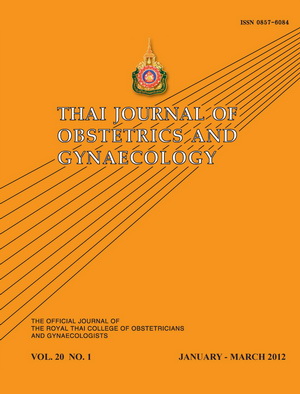Vaginal health in copper intrauterine device users and non-users
Main Article Content
Abstract
Objective: To compare the cervicovaginal flora, vaginal symptoms, infections and pH between copper intrauterine device (IUD) users and non-IUD, non-hormonal users
Materials and Methods: A cross-sectional study was conducted from August 2010 to March 2011 at Ramathibodi Hospital. Ninety-two women at the age of 18-45 yr of whom 46 were copper IUD users while other 46 were nonusers. Each woman was evaluated clinically with direct observation of vaginal secretions, wet mount examination, Whiff test, vaginal pH testing and cervicovaginal culture. The outcomes included prevalence of aerobic and anaerobic bacteria colonization, bacterial vaginosis, vaginal candidiasis, trichomoniasis, vaginal symptoms and vaginal pH.
Results: There was no difference in prevalence of aerobic (50% VS 54.3%; P=0.67) and anaerobic (82.6%VS 76.1%; P=0.44) colonization between two groups. Vaginal symptoms, candidiasis and trichomoniasis were not significantly different. Prevalence of bacterial vaginosis was significantly higher among IUD users than non-IUD users. (28.3% VS 10.9%; P=0.03). The mean vaginal pH was significantly higher in IUD group (5.3±0.6 VS 4.8±0.8; P <0.05).
Conclusion: Copper intrauterine device altered vaginal pH and bacterial vaginosis was more common among IUD users.

